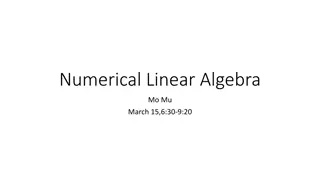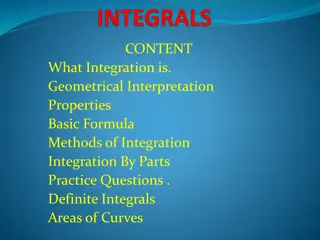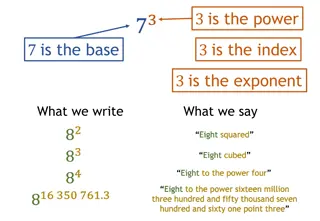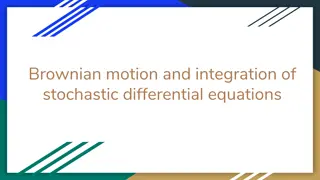Numerical Integration in Numerical Methods
This lecture covers the fundamentals of numerical integration, including upper and lower sums, trapezoid method, Romberg method, Gauss quadrature, definite and indefinite integrals, the fundamental theorem of calculus, and the area under the curve. The concepts are explained with examples and calculations to help understand the numerical methods for integration. Various methods and interpretations related to numerical integration in mathematics are discussed in detail.
Download Presentation

Please find below an Image/Link to download the presentation.
The content on the website is provided AS IS for your information and personal use only. It may not be sold, licensed, or shared on other websites without obtaining consent from the author.If you encounter any issues during the download, it is possible that the publisher has removed the file from their server.
You are allowed to download the files provided on this website for personal or commercial use, subject to the condition that they are used lawfully. All files are the property of their respective owners.
The content on the website is provided AS IS for your information and personal use only. It may not be sold, licensed, or shared on other websites without obtaining consent from the author.
E N D
Presentation Transcript
CISE301: Numerical Methods Topic 7 Numerical Integration Lecture 24-27 KFUPM Read Chapter 21, Section 1 Read Chapter 22, Sections 2-3 CISE301_Topic7 KFUPM 1
Lecture 24 Introduction to Numerical Integration Definitions Upper and Lower Sums Trapezoid Method (Newton-Cotes Methods) Romberg Method Gauss Quadrature Examples CISE301_Topic7 KFUPM 2
Integration Definite Integrals Indefinite Integrals 1 1 2 2 1 x 2 x = + = = x dx c xdx 2 2 0 0 Indefinite Integrals of a function are functions that differ from each other by a constant. Definite Integrals are numbers. CISE301_Topic7 KFUPM 3
Fundamental Theorem of Calculus If is continuous on an interval is antiderivative F , f [a,b] F = of (i.e., ' ( ) f ( ) ) f x x b = F(b) F(a) f(x)dx a 2 x There is no antiderivat for: i e v e b 2 x Noclosed form solution fo r: e dx a CISE301_Topic7 KFUPM 4
The Area Under the Curve One interpretation of the definite integral is: Integral = area under the curve f(x) b af(x)dx = Area a b CISE301_Topic7 KFUPM 5
Upper and Lower Sums The interval is divided into subintervals. = = = ... Partition P a x x x x b 0 1 2 n Define = min ( : ) m f x ( x x x f(x) + 1 i i x i x = max : ) M f x x + 1 i i i 1 n ( ) = ( , ) Lower sum L f P m x x + 1 i i i = 0 i 1 n ( ) = ( , ) Upper sum U f P M x x x x x x + 1 i i i 0 1 2 3 = 0 i a b CISE301_Topic7 KFUPM 6
Upper and Lower Sums 1 n ( ) = ( , ) Lower sum L f P m x x + 1 i i i = 0 i 1 n ( ) f(x) = ( , ) Upper sum U f P M x x + 1 i i i = 0 i + L U = Estimate of the integral 2 U L Error 2 x x x x 0 1 2 3 a b CISE301_Topic7 KFUPM 7
Example 1 2 x dx 0 1 2 3 = : , 0 , , 1 , Partition P 4 4 4 = 4 ( four equal intervals ) n 1 1 9 = = = = , 0 , , m m m m 0 1 2 3 16 4 16 1 1 9 = = = = , , , 1 M M M M 0 1 2 3 16 4 16 1 1 1 3 = = 0 1 3 , 2 , 1 , 0 x x for i + 1 i i 4 2 4 4 CISE301_Topic7 KFUPM 8
Example 1 n ( ) i = ( , ) Lower sum L f P m x x + 1 i i i = 0 1 1 1 9 14 = + + + = ( , ) 0 L f P 4 16 4 16 64 1 n ( ) i = ( , ) Upper sum U f P M x x + 1 i i i = 0 1 1 1 9 30 = + + + = ( , ) 1 U f P 4 16 4 16 64 1 30 14 11 = + = Estimate of the integral 2 64 64 32 1 30 14 1 = Error 2 64 64 8 1 1 3 0 1 4 2 4 CISE301_Topic7 KFUPM 9
Upper and Lower Sums Estimates based on Upper and Lower Sums are easy to obtain for monotonic functions (always increasing or always decreasing). For non-monotonic functions, finding maximum and minimum of the function can be difficult and other methods can be more attractive. CISE301_Topic7 KFUPM 10
Newton-Cotes Methods In Newton-Cote Methods, the function is approximated by a polynomial of order n. Computing the integral of a polynomial is easy. ( 0 1 ( ) a a ) b b + + + n ... f x dx a a x a x dx n + + + 2 2 1 1 n n ( ) ( ) b a b a b + + + ( ) f x dx ( a b a ) ... a a 0 1 n 2 1 n a CISE301_Topic7 KFUPM 11
Newton-Cotes Methods Trapezoid Method (First Order Polynomials are used) b b ( ) + ( ) f x dx a a x dx 0 1 a a Simpson 1/3 Rule (Second Order Polynomials are used) ( a a ) b b 2 + + ( ) f x dx a a x a x dx 0 1 2 CISE301_Topic7 KFUPM 12
Lecture 25 Trapezoid Method Derivation-One Interval Multiple Application Rule Estimating the Error Recursive Trapezoid Method Read 21.1 CISE301_Topic7 KFUPM 13
Trapezoid Method b = ( ) I f x dx ( ) ( ) f b f a a + ( ) ( ) f a x a b a ( ) ( ) f b f a b + ( ) ( ) I f a x a dx b a a f(x) b ( ) ( ) f b f a = ( ) f a a x b a a b 2 ( ) ( ) f b f a x + 2 b a a a b + ( ) ( ) f b f a ( ) = b a 2 CISE301_Topic7 KFUPM 14
Trapezoid Method Derivation-One Interval ( ) ( ) f b f a b b = + ( ) ( ) ( ) I f x dx f a x a dx b a a a ( ) ( ) ( ) ( ) f b f a f b f a b + ( ) I f a a x dx b a b a a b b 2 ( ) ( ) ( ) ( ) f b f a f b f a x = + ( ) f a a x 2 b a b a a a ( ) ( ) ( ) b ( ) f b f a f b f a ( ) = + 2 2 ( ) ( ) f a a b a b a ( 2 ) b a a + ( ) ( ) f b f a ( ) = b a 2 CISE301_Topic7 KFUPM 15
Trapezoid Method f(x) (b ) f (a ) f b a ( ) ) b = + ( ) ( Area f a f 2 a b CISE301_Topic7 KFUPM 16
Trapezoid Method Multiple Application Rule + ( ) ( ) f x f x ( ) = 2 1 Area x x 2 1 2 f(x) The interval [a, b] is partitione = a into d x segments n = ... a x x x b 0 1 2 n b = ( ) sum of the areas f x dx of the trapezoid s x x x x x 0 1 2 3 a b CISE301_Topic7 KFUPM 17
Trapezoid Method General Formula and Special Case If a the x = interval x is divided into b segments n (not necessaril equal) y = ... x x 0 1 2 n 1 1 n = ( )( ) ) i x b + ( ) ( ) ( f x dx x x f x f + + 1 1 i i i 2 a 0 i Special Case (Equalliy spaced base points) for all i i x x h i + = 1 1 2 1 n b + + ( ) f x dx ( ) f x ( ) ( ) f x h f x 0 n i a = 1 i CISE301_Topic7 KFUPM 18
Example Given a tabulated values of the velocity of an object. Time (s) 0.0 1.0 2.0 3.0 Velocity (m/s) 0.0 10 12 14 Obtain an estimate of the distance traveled in the interval [0,3]. Distance = integral of the velocity Distance 3 = ( ) V t dt 0 CISE301_Topic7 KFUPM 19
Example 1 The interval divided is Time (s) 0.0 1.0 2.0 3.0 into 3 subinterva ls Velocity (m/s) 0.0 10 12 14 3 , 2 , 1 , 0 are Base points Trapezoid Method = = 1 h x x + 1 i i 1 1 n ( ) = i = + + ( ) ( ) ( ) T h f x f x f x 0 i n 2 1 1 = + + + = Distance 1 (10 12) 0 ( 2 14 ) 29 CISE301_Topic7 KFUPM 20
Estimating the Error For Trapezoid Method How many equally spaced intervals are 0 needed compute to sin( ) x dx decimal 5 to digit accuracy ? CISE301_Topic7 KFUPM 21
Error in estimating the integral Theorem is ) ( ' ' : Assumption x f continuous on = [a,b] Equal intervals (width ) h Theorem : If Trapezoid Method is used to b approximat e ( ) then f x dx a b a = 2 ' ' ( ) Error h f where [a,b] 12 b a 2 max [ a x ( ' ' ) Error h f x 12 , ] b CISE301_Topic7 KFUPM 22
Example 1 5 sin( ) , error 10 x dx find h so that 2 0 b a 2 max = ( ' ' ) Error h f x 12 [ , cos( ] x a b = = = ; ; 0 ( ' ) ); ( ' ' ) sin( ) b a f x x f x x 1 2 5 ( ' ' ) 1 10 f x Error h 12 2 6 2 5 10 h CISE301_Topic7 KFUPM 23
Example x 1.0 1.5 2.0 2.5 3.0 f(x) 2.1 3.2 3.4 2.8 2.7 3 Use Trapezoid method compute to : ( ) f x dx 1 1 1 n ( )( ) = i = + ( , ) ( ) ( ) Trapezoid T f P x x f x f x + + 1 1 i i i i 2 x 0 = : for all , Special Case h x i + 1 i i 1 1 n ( ) = i = + + ( , ) ( ) ( ) ( ) T f P h f x f x f x 0 i n 2 1 CISE301_Topic7 KFUPM 24
Example x 1.0 1.5 2.0 2.5 3.0 f(x) 2.1 3.2 3.4 2.8 2.7 1 n 1 3 ( ) = i + + ( ) ( ) ( ) ( ) f x dx h f x f x f x 0 i n 2 1 1 1 ( 1 . 2 ) = 4 . 3 + 8 . 2 + + 7 . 2 + 5 . 0 2 . 3 2 9 . 5 = CISE301_Topic7 KFUPM 25
Recursive Trapezoid Method Estimate based on one interval : f(x) = h b a b a ( ) ) b = + ) 0 , 0 ( R ( ) ( f a f 2 + a a h CISE301_Topic7 KFUPM 26
Recursive Trapezoid Method Estimate based on intervals 2 : f(x) Recall special case of Trapezoid Method!! b a = h 2 1 b a ( ) = + + + ) 0 , 1 ( R ( ) ( ) ( ) f a h f a f b 2 2 1 ) h = + + ) 0 , 1 ( R ) 0 , 0 ( R ( h f a 2 + + 2 a a h a h Based on previous estimate Based on new point CISE301_Topic7 KFUPM 27
Recursive Trapezoid Method f(x) b a = h 4 b a = + + + + + ) 0 , 2 ( R ( ) ( 2 ) ( 3 ) f a h f a h f a h 4 1 ( ) + + ( ) ( ) f a f b 2 1 ) h = + + + + ) 0 , 2 ( R ) 0 , 1 ( R ( ) ( 3 h f a h f a 2 + + 2 4 a a h a h Based on previous estimate Based on new points CISE301_Topic7 KFUPM 28
Recursive Trapezoid Method Formulas b a = + ) 0 , 0 ( R ( ) ( ) f a f b 2 ) 1 (2 = n 1 ( ) = ) 0 , 1 + 2 ( + ) 1 ( ) 0 , ( R n R n h f a k h 2 1 k b a = h n 2 CISE301_Topic7 KFUPM 29
Recursive Trapezoid Method 2 b a = = + , ) 0 , 0 ( R ( ) ( ) h b a f a f b 2 1 1 b a ( ) = k = = + + , ) 0 , 1 ( R ) 0 , 0 ( R 2 ( ) 1 h h f a k h 2 1 2 2 1 b a ( ) = k = = + + , ) 0 , 2 ( R ) 0 , 1 ( R 2 ( ) 1 h h f a k h 2 2 1 2 2 2 1 b a ( ) = k = = + + , ) 0 , 3 ( R ) 0 , 2 ( R 2 ( ) 1 h h f a k h 3 2 1 .......... ........ ) 1 ( n 2 2 1 b a ( ) = k = = + + , ( ) 0 , n ( ) 0 , 1 2 ( ) 1 h R R n h f a k h n 2 1 CISE301_Topic7 KFUPM 30
Advantages of Recursive Trapezoid Recursive Trapezoid: Gives the same answer as the standard Trapezoid method. Makes use of the available information to reduce the computation time. Useful if the number of iterations is not known in advance. CISE301_Topic7 KFUPM 31
Lecture 26 Romberg Method Motivation Derivation of Romberg Method Romberg Method Example When to stop? Read 22.2 CISE301_Topic7 KFUPM 32
Motivation for Romberg Method Trapezoid formula with an interval h gives an error of the order O(h2). We can combine two Trapezoid estimates with intervals 2h and h to get a better estimate. CISE301_Topic7 KFUPM 33
Romberg Method Estimates using Trapezoid method with intervals of size , 2 , 4 ,8 ,... h h h h b are combined to improve the approximation of ( ) f x dx a R(0,0) First column is obtained using Trapezoid Method R(1,0) R(1,1) R(2,0) R(2,1) R(2,2) R(3,0) R(3,1) R(3,2) R(3,3) The other elements are obtained using the Romberg Method CISE301_Topic7 KFUPM 34
First Column Recursive Trapezoid Method b a = + ) 0 , 0 ( R ( ) ( ) f a f b 2 ) 1 (2 = n 1 ( ) = ) 0 , 1 + 2 ( + ) 1 ( ) 0 , ( R n R n h f a k h 2 1 k b a = h n 2 CISE301_Topic7 KFUPM 35
Derivation of Romberg Method n b a b = ) 0 , 1 + = 2 ( ) ( ( ) Trapezoid method f x dx R n O h with h 1 2 a b = ) 0 , 1 + + + + 2 4 6 ( ) ( ... ( ) 1 f x dx R n a h a h a h eq 2 4 6 a More accurate estimate obtained is by R(n,0) 1 1 1 b eq = + + + + 2 4 6 ( ) ( ) 0 , n ... ( ) 2 f x dx R a h a h a h eq 2 4 6 4 16 64 a 1 4 * 2 eq gives 1 b = + ) 0 , 1 + + + 4 6 ( ) ( ) 0 , n ( ) 0 , n ( ... f x dx R R R n b h b h 4 6 3 a CISE301_Topic7 KFUPM 36
Romberg Method b a R(0,0) R(1,0) = + ) 0 , 0 ( R ( ) ( ) f a f b 2 R(1,1) R(2,0) R(2,1) R(2,2) b a = , h R(3,0) R(3,1) R(3,2) R(3,3) n 2 ) 1 (2 = k n 1 ( ) = ) 0 , 1 + 2 ( + ) 1 ( ) 0 , n ( R R n h f a k h 2 1 1 = ) 1 + ) 1 , 1 ) 1 ( , ) ( , ( , ( R n m R n m R n m R n m m 4 m 1 , 1 1 for n CISE301_Topic7 KFUPM 37
Property of Romberg Method R(0,0) R(1,0) R(1,1) R(2,0) R(2,1) R(2,2) R(3,0) R(3,1) R(3,2) R(3,3) Theorem b a 2 + m = + 2 ( ) ( , ) ( ) f x dx R n m O h 2 4 6 8 ( ) ( ) ( ) ( ) O h O h O h O h Error Level CISE301_Topic7 KFUPM 38
Example 1 1 2 Compute x dx 0.5 3/8 1/3 0 1 b a = = + = + = , 1 ) 0 , 0 ( R ( ) ( ) 0 1 5 . 0 h f a f b 2 2 1 1 1 1 1 1 3 = = + + = + = , ) 0 , 1 ( R ) 0 , 0 ( R ( ( )) h h f a h 2 2 2 2 2 4 8 1 = ) 1 + ) 1 , 1 ) 1 ( , ) ( , ( , ( R n m R n m R n m R n m m 4 m 1 , 1 1 for n 1 3 1 3 1 1 = + = + = ) 1 , 1 ( R ) 0 , 1 ( R ) 0 , 1 ( R ) 0 , 0 ( R 1 8 3 8 2 3 4 1 CISE301_Topic7 KFUPM 39
0.5 Example 1 (cont.) 3/8 1/3 11/32 1/3 1/3 1 4 1 2 1 3 2 8 1 4 16 1 9 11 32 = = + + + + = + + = , (2,0) (1,0) ( ( h f a ) ( 3 )) h h R R h f a 16 1 = + ( , ) R n m ( , 1) ( , 1) ( 1, 1) R n m R n m R n m m 4 1 1 11 32 1 3 1 11 3 32 1 1 15 3 3 8 1 3 = + = + = (2,1) (2,0) (2,0) (1,0) R R R R 1 4 1 1 1 3 1 3 = + = + = (2,2) (2,1) (2,1) (1,1) R R R R 2 4 1 CISE301_Topic7 KFUPM 40
When do we stop? STOP if ) 1 , 1 ) 1 ( , ( R n m R n m or After a given number of steps, for example, STOP R(4,4) at CISE301_Topic7 KFUPM 41
Lecture 27 Gauss Quadrature Motivation General integration formula Read 22.4 CISE301_Topic7 KFUPM 42
Motivation Large overall error Figure 22.6, p. 641 Smaller overall error CISE301_Topic7 KFUPM 43
Motivation (Contd.) Trapezoid Method: 1 2 1 n b ( ) = + + ( ) f x dx ( ) f x ( ) f x ( ) h f x 0 i n a = 1 i It can be expressed as: n b = ( ) f x dx ( ) c f x i i a = 0 i = = 1,2,..., 0 and n 1 h i i n = where c i 0.5 h CISE301_Topic7 KFUPM 44
General Integration Formula n b = ( ) f x dx ( ) c f x i i a = 0 i : : c Weights x Nodes i i : Questi o n Can we se bette r lect so that the formula gives a c and x i i approximation of the integral? CISE301_Topic7 KFUPM 45
Question What is the best way to choose the nodes and the weights? CISE301_Topic7 KFUPM 46
Question (Contd.) From previous figure, the integration is exact for a polynomial of order 3 with 4 points (c0, c1, x0, and x1) Integrate each of the four f(x) polynomials ( ) 2 3 1, , , x x x 1 1 Solve for c0, c1, x0, and x1 c0 = c1 = 1, x0 = , x1 = 3 3 CISE301_Topic7 KFUPM 47
GaussLegendre Quadrature (generalization of previous example) An n-point Gauss-Legendre Quadrature rule is constructed to yield an exact result for polynomials of degree2n 1 or less by a suitable choice of the pointsxiand weightscifori = 1, ..., n. n b ( ) f x dx ( ) c f x i i a = 0 i 2 = , where c i 2 ( ) 2 i (1 ) x P x n i + 1 n k n k n = n k ( ) 2 P x x 2 n n = 0 k Source: https://en.wikipedia.org/wiki/Gaussian_quadrature and https://en.wikipedia.org/wiki/Legendre_polynomials CISE301_Topic7 KFUPM 48
GaussLegendre Quadrature See more in Table 22.1 (page 646) n 1 = ( ) f x dx ( ) c f x i i 1 = 0 i = = = = = = 1 0.57735, 1, 0.774596, 0.555556, 0.86113, = 0.34785, 0.906179, 0.236926, = 0.57735 1 0.000000, 0.888889, 0.33998, 0.65214, 0.538469, 0.478628, n x x 0 1 c x = = = x c (2 pts.) n = 0 1 = = 2 0.774596 0.555556 0.33998, 0.65214, 0.00000, 0.568889, = x c 0 1 c = = = = 2 c (3 pts.) n = 0 1 2 = = = 3 0.86113 0.34785 0.538469, 0.478628, c = x x x x c x 0 1 c x 2 3 c = = = c (4 n pts.) 4 = 0 1 2 3 = = = 0.906179 0.236926 = x c x x 0 1 c 2 3 4 c c (5 pts.) 0 1 2 3 4 CISE301_Topic7 KFUPM 49
Error Analysis for Gauss Quadrature b Let the integral ( ) f x dx be approximated by: a n b ( ) f x dx ( ) c f x i i a = 0 i are selected according to where c and x i i the Gauss Quadrature formula, Then, the true error satisfies: 2 Error (2 3) (2 n + + + 2 3 4 n ( 1)! + n + = ( ), [ 1,1] (2 2) n f 3 2)! n + The formula will be exact for all polynomials of order 2 1 n CISE301_Topic7 KFUPM 50























